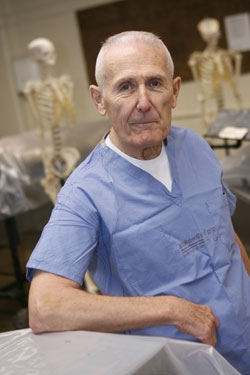In the lab for a lifetime … and beyond
Temple pays tribute to longtime Medical School professor
In a class of 180 incoming students, it’s easy to be anonymous. But Dr. Carson Schneck, M.D., PhD., doesn’t let that happen to the doctors-in-training at Temple University’s School of Medicine. Before the students walk into his "Human Gross Anatomy" classroom, he knows each and every one of them.
“In a lecture hall environment, they are just faceless people sitting there,” says Schneck. “I think it’s important in teaching to get to know the students as people.”
For Schneck, teaching begins with getting to know his students before the school year even starts. He spends a weekend in August memorizing student ID pictures until he can place a name with every face. It’s just one part of what has made him one of the most unforgettable professors at Temple, having carved out a provincial career path on campus, teaching anatomy and more since 1960.
“I was a freshman in 1960 and my memories are of him being a very enthusiastic guy,” says Dr. Albert Alley, M.D., an ophthalmologist who was in Schneck’s very first "Human Gross Anatomy" lab. “He had a novel way of presenting a topic that might not have been a dynamic topic. He always had a group of students around him explaining something.”
For nearly 50 years, Schneck has introduced first-year med school students like Alley to their first patient: a cadaver. When he began teaching, cadavers were often homeless people or drifters. Now, it’s a much different story, as people donate their bodies for medical education and scientific research.
Perhaps that is why Schneck respects the cadaver so much. He understands that all he knows about the study of the human body begins, not in life, but in death. It’s that respect he passes along to his students in a Socratic teaching. Don’t expect to see Schneck lecture; instead, he poses problems and challenges students to solve them to prove they understand the anatomy they are learning.
“He picks up an anatomy probe and plunges it into the cadaver’s chest,” reminisces Dr. Fred Hartman, M.D.’69, who says Schneck then asked the students to name all the structures his probe went through. “Invariably, we would miss one, and Carson would smile, his point made.”
His point is that life is about learning and it never stops, not even for a 74-year-old professor of anatomy, who knows the human body, well, like the back of his manus, or hand. His accomplishments are many, having earned his M.D. at Temple in 1959 and the very first Ph.D. in anatomy and cell biology at Temple.
Schneck may have chosen to teach class instead of becoming a clinician, but that hasn’t lessened his impact on thousands of doctors in the greater Philadelphia region. For nearly 30 years, all kinds of physicians, from radiologists to psychiatrists, have been required to get re-certification in their specialty every 10 years. Who do they turn to for their post-graduate and continuing medical education training? Dr. Carson Schneck.
It’s seems only fitting that Temple University repay the favor of this professor’s dedication. The school has launched a million dollar campaign for the Carson D. Schneck Gross Anatomy Laboratory in the new medical school, set to open in fall of 2009. The lab will boast the latest technology; Computers above every dissecting table, allowing students to get instruction while watching streaming video right at their workstation. It’s ironic that such a high-tech facility should bear Schneck’s name. “I was sort of dragged kicking and screaming into the computer age, but you have to use computers to teach these days. I’m excited.”
And when the ultramodern lab opens, Schneck will be right there helping to apply the newest technologies. But you can bet students, using the same teaching style that has stuck with doctors-to-be since 1960, will still surround him.
“You don’t leave anything behind in this life except the imprints you put on other people,” said Schneck “I adopted other people’s traits and hopefully I can communicate some of the other good traits to other people.”
For more information on the Carson D. Schneck Gross Anatomy Laboratory Campaign, visit www.temple.edu/medicine/alumni/schneck_campaign.htm.
